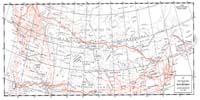Alfred Waddington
With the last spike having been driven on May 10, 1869 joining the Central Pacific Railway with that of the Union Pacific at Promontory, Utah, it became even more important and urgent that a Canadian transcontinental railway be built in order to maintain the commercial ties between England and the Far East, for which American lines posed a threat.
Waddington’s 1868 pamphlet is largely given over to dismissing the objections to a railway through British territory. There were two main obstacles, one physical the other human, both surmounted by 1871. The mountain barrier of the Rockies had been breached through the Yellowhead Pass, and the Hudson’s Bay Company had relinquished its possession of Rupert’s Land on payment of 300,000 pounds. The way was now clear. Fears about the climate, lack of population, the American “threat,” and the cost of building a railway were allayed. Waddington estimated that the railway distance from Ottawa to Butte Inlet (his choice for the Pacific terminus), via Yellowhead Pass, the Chilcoaten Plain and the Homathco River to be 2885 miles, and the line would cost $130,150,000 to build. Existing rail lines would be used to the east coast. To forestall objections to such an amount being spent, he argued that the failure to build would incur far greater losses in trade and territory, even the possible “decay and ruin of our country.” To offset such an outlay by the government, Waddington suggested that a private company be induced to construct the railway by
...offering liberal grants of land...by engaging to subsidize mail steamers in connexion with the line...on the Atlantic and Pacific Oceans...by authorizing the company to issue mortgage bonds to a certain amount: and by paying the interest as a bonus or encouragement..., until the road was completed and self paying.
Failing to obtain financial support in England and the backing of the Imperial government, being unsuccessful in obtaining a charter for a railway, and spurned as of no political and financial consequence by American entrepreneurs whom he tried to enlist in his cause, Waddington was finally defeated.1 Soon after this, in 1872, he died of smallpox. But a fitting epitaph to Waddington’s unremitting toil and promotion for a transcontinental railway was the recommendation by Sandford Fleming, Engineer-in-Chief of the Canadian Pacific Railway, that Waddington’s survey notes for a route in British Columbia be bought by the government in order to save the expense of a duplicate survey. The government granted Fleming’s wish.2 And, as is often said, the rest is history.
Notes | Bibliography | Abbreviations
1. Pierre Burton, The National Dream (Toronto: McClelland and Stewart, 1970), pp. 61, 65.; L.B. Irwin. Pacific Railways and Nationalism in the Canadian-American Northwest, 1845–1873 (New York: Greenwood Press, 1968), p. 158.2. Ibid.
